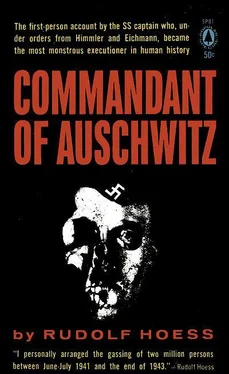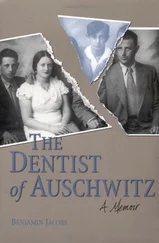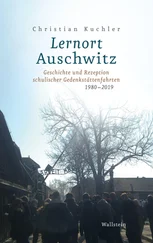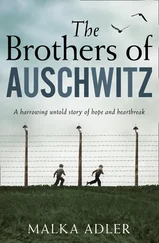By the will of the Reichsführer SS, Auschwitz became the greatest human extermination center of all time.
When in the summer of 1941 he himself gave me the order to prepare installations at Auschwitz where mass exterminations could take place, and personally to carry out these exterminations, I did not have the slightest idea of their scale or consequences. It was certainly an extraordinary and monstrous order. Nevertheless the reasons behind the extermination program seemed to me right. I did not reflect on it at the time: I had been given an order, and I had to carry it out. Whether this mass extermination of the Jews was necessary or not was something on which I could not allow myself to form an opinion, for I lacked the necessary breadth of view.
If the Führer had himself given the order for the “final solution of the Jewish question,” then, for a veteran National Socialist and even more so for an SS officer there could be no question of considering its merits. “The Führer commands, we follow” was never a mere phrase or slogan. It was meant in bitter earnest.
Since my arrest it has been said to me repeatedly that I could have disobeyed this order, and that I might even have assassinated Himmler, I do not believe that of all the thousands of SS officers there could have been found a single one capable of such a thought. It was completely impossible. Certainly many SS officers grumbled and complained about some of the harsh orders that came from the Reichsführer SS, but they nevertheless always carried them out.
Many orders of the Reichsführer SS deeply offended a great number of his SS officers, but I am perfectly certain that not a single one of them would have dared to raise a hand against him, or would have even contemplated doing so in his most secret thoughts. As Reichsführer SS, his person was inviolable. His basic orders, issued in the name of the Führer, were sacred. They brooked no consideration, no argument, no interpretation. They were carried out ruthlessly and regardless of consequences, even though these might well mean the death of the officer concerned, as happened to not a few SS officers during the war.
It was not for nothing that during training the self-sacrifice of the Japanese for their country and their emperor, who was also their god, was held up as a shining example to the SS.
SS training was not comparable to a university course which can have as little lasting effect on the students as water on a duck’s back. It was on the contrary something that was deeply ingrained, and the Reichsführer SS knew very well what he could demand of his men.
But outsiders simply cannot understand that there was not a single SS officer who would disobey an order from the Reichsführer SS, far less consider getting rid of him because of the gruesomely hard nature of one such order.
What the Führer, or in our case his second-in-command, the Reichsführer SS, ordered was always right.
Democratic England also has a basic national concept: “My country, right or wrong!” and this is adhered to by every nationally conscious Englishman.
Before the mass extermination of the Jews began, the Russian politruks and political commissars were liquidated in almost all the concentration camps during 1941 and 1942.
In accordance with a secret order issued by Hitler, these Russian politruks and political commissars were combed out of all the prisoner-of-war camps by special detachments from the Gestapo. [73]
When identified, they were transferred to the nearest concentration camp for liquidation. It was made known that these measures were taken because the Russians had been killing all German soldiers who were Party members or belonged to special sections of the NSDAP, especially members of the SS, and also because the political officials of the Red Army had been ordered, if taken prisoner, to create every kind of disturbance in the prisoner-of-war camps and their places of employment and to carry out sabotage wherever possible.
The political officials of the Red Army thus identified were brought to Auschwitz for liquidation. The first, smaller transports of them were executed by firing squads,
While I was away on duty, my deputy, Fritzsch, the commander of the protective custody camp, first tried gas for these killings. It was a preparation of prussic acid, called Cyclon B [74], which was used in the camp as an insecticide and of which there was always a stock on hand. On my return, Fritzsch reported this to me, and the gas was used again for the next transport.
The gassing was carried out in the detention cells of block 11. Protected by a gas mask, I watched the killing myself. In the crowded cells death came instantaneously the moment the Cyclon B was thrown in. A short, almost smothered cry, and it was all over. During this first experience of gassing people, I did not fully realize what was happening, perhaps because I was too impressed by the whole procedure. I have a clearer recollection of the gassing of nine hundred Russians which took place shortly afterward in the old crematorium, since the use of block 11 for this purpose caused too much trouble. While the transport was detraining, holes were pierced in the earth and concrete ceiling of the mortuary. The Russians were ordered to undress in an anteroom; they then quietly entered the mortuary, for they had been told they were to be deloused. The whole transport exactly filled the mortuary to capacity. The doors were then sealed and the gas shaken down through the holes in the roof. I do not know how long this killing took. For a little while a humming sound could be heard. When the powder was thrown in, there were cries of “Gas!,” then a great bellowing, and the trapped prisoners hurled themselves against both the doors. But the doors held. They were opened several hours later, so that the place might be aired. It was then that I saw, for the first time, gassed bodies in the mass.
It made me feel uncomfortable and I shuddered, although I had imagined that death by gassing would be worse than it was. I had always thought that the victims would experience a terrible choking sensation. But the bodies, without exception, showed no signs of convulsion. The doctors explained to me that the prussic acid had a paralyzing effect on the lungs, but its action was so quick and strong that death came before the convulsions could set in, and in this its effects differed from those produced by carbon monoxide or by a general oxygen deficiency.
The killing of these Russian prisoners of war did not cause me much concern at the time. The order had been given, and I had to carry it out. I must even admit that this gassing set my mind at rest, for the mass extermination of the Jews was to start soon and at that time neither Eichmann [75]nor I was certain how these mass killings were to be carried out. It would be by gas, but we did not know which gas or how it was to be used. Now we had the gas, and we had established a procedure. I always shuddered at the prospect of carrying out exterminations by shooting, when I thought of the vast numbers concerned, and of the women and children. The shooting of hostages, and the group executions ordered by the Reichsführer SS or by the Reich Security Head Office had been enough for me. I was therefore relieved to think that we were to be spared all these blood baths, and that the victims too would be spared suffering until their last moment came. It was precisely this which had caused me the greatest concern when I had heard Eichmann’s description of Jews being mown down by the Special Squads armed with machine guns and machine pistols. [76]
Many gruesome scenes are said to have taken place, people running away after being shot, the finishing off of the wounded and particularly of the women and children. Many members of the Einsatzkommandos, unable to endure wading through blood any longer, had committed suicide. Some had even gone mad. Most of the members of these Kommandos had to rely on alcohol when carrying out their horrible work. According to Höfle’s description, the men employed at Globocnik’s [77]extermination centers consumed amazing quantities of alcohol. [78]
Читать дальше












